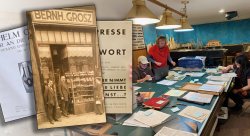Students of German Transcribe and Translate Estate of Prominent Austrian Composer Wilhelm Grosz
Posted in: CHSS Newsletter, Homepage News and Events, Student News, World Languages and Cultures

When the National Socialists invaded Austria in 1934, the highly successful composer Wilhelm Grosz left for London and then New York, where he continued composing music later sung by such greats as Frank Sinatra. After Grosz died in 1939, much of his estate was eventually passed to the international Exil.arte organization. This spring, Grosz’s granddaughter asked Montclair’s German program to organize, transcribe, and translate many newly discovered estate materials.
Dr. Pascale LaFountain assembled a team of highly qualified and motivated students: Bianca Isabella Zárate González, a triple major in Language Business Culture, German, and Data Science; Noah Stevens, a Music Performance Violist with a minor in German; and Connor Gargiulo, a double major in German and Linguistics. Grosz’s granddaughter Diane Forman-Berg acknowledges, “They really helped me. I do not speak any German. I was so overwhelmed and wanted to get this job done right for the sake of my family’s legacy and future researchers,” Ms. Forman-Berg says. While Noah organized the handwritten musical scores, the rest of the team created scans, summaries, and translations of letters and other documents, preparing them for the team of Austrian scholars who returned in May to formally acquire the materials.
Among the narratives of artistic negotiations, the team found letters to and from Irving Berlin, Langston Hughes, Oscar Hammerstein and others, as well as a pocket watch and other artifacts. The team also translated many letters, as well as Nazi forms documenting the family’s assets and the dispossession of the family’s property in Vienna in 1938. Isabella Zárate recalls, “I was so surprised when I first saw the word ‘Entjudung’ [dejewification]. It’s one thing to learn about Nazis in class, but very different when the families affected are sitting next to you.”
Pages with swastikas at the top rationalize taking away the family’s home and include statements from a father apologizing for his late documentation because he was under the “Schutzhaft” [custody] of the Gestapo. When asked to translate an unusual note with a strange format, the team realized it was an inventory of the jewels that Wilhelm Grosz’s mother had secretly taken with her when she was forced to leave. In the middle of the translation mentioning a platinum duck pendant with a diamond in it, Mrs. Forman-Berg suddenly pulled this pendant out of her collar to show it to the translators.
As a growing expert in data science, language, and cultural studies, Isabella Zárate was in charge of making sure the team was maximizing the use of technology without compromising quality and precision. She describes, “We can use some text recognition software, but many of the handwritten materials are beyond what the software can recognize or they use vocabulary in a very particular way, and we want to be sure we are getting things right, so the work still requires a lot of attention to detail.”
Students in the Montclair German program learn about fascist aesthetics, politics, and German history in courses such as the faculty-led “Nazi Cinema and Propaganda” travel course that takes students to Germany. This project allowed students to apply all of their linguistic and cultural knowledge to help community understanding of German and Jewish history. The project reminded Dr. LaFountain of a project she and Brian Concannon (German and Arabic double major, ‘23) did last year transcribing and translating letters from a Jewish family who had continued to correspond in German throughout the 1950s after some family members had resettled in the New York area and others had moved to Argentina. “These public serving translation projects are some of the most rewarding work we do, keeping memories alive and helping other generations not just read about, but feel the consequences of authoritarianism, war, and genocide.”
Grosz’s popular songs such as “The Isle of Capri” and “Harbour Lights” continue to be played today, as one can hear on shows such as “The Marvelous Mrs. Maisel.” Thanks to the Montclair team, Grosz’s family, scholars, and international audiences can learn more about the life that Grosz and those around him led as he created his timeless work.
